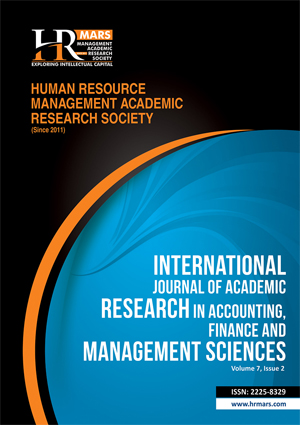
ISSN: 2225-8329
Open access
The aquaculture sector has been recognized as a crucial and high-priority area in Malaysia's economic development. The study's goal is to investigate the accounting practices used by Malaysian aquaculture-listed firms. As samples, two listed aquaculture enterprises were chosen. The accounting processes of the listed aquaculture companies were examined using content analysis. By looking at how the aquaculture business was covered in the annual reports of these chosen companies, the study's goal was achieved. The study specifically looked at the listed businesses' accounting processes for aquaculture definition, recognition, measurement, presentation, and disclosure. The major conclusions showed that the two companies accounting practices in terms of biological asset-aquaculture definition, recognition, measurement, presentation, and disclosure comply with the standards of MFRS 141 Agriculture. The findings of this study added to our understanding of agricultural accounting. The findings will offer new aquaculture-listed firms accounting best practices guidelines. The findings are also anticipated to help Malaysian businesses embrace MFRS 141 by improving the regulatory environment.
Adobor, H. (2019). Entrepreneurial Failure in Agribusiness: Evidence from an Emerging of the Economy, Journal of Small Business and Enterprise Development. Volume. 27 No. 2, pp. 237-258.
Anderson, J. L., Asche, F., Garlock, T.. & Chu J, (2017). Aquaculture, Its Role in the Future of Food, Frontiers of Economics and Globalization, Volume 17 ISSN: 1574-8715 pp. 159-173.
Fast, A. W. (1994). Effects of broodstock size and source on ovarian maturation and spawning on Penaeus monodon Fabricius from the Gulf of Thailand. Journal of the World Aquaculture Society, 25(1), pp. 41–49.
Jumatli, A., & Ismail, M. S. (2021). Promotion of sustainable aquaculture in Malaysia. In Proceedings of the International Workshop on the Promotion of Sustainable Aquaculture, Aquatic Animal Health, and Resource Enhancement in Southeast Asia, pp. 31-40.
Kamaruddin, R., & Baharuddin. A. H. (2014). The importance of good aquaculture practices in improving fish farmer’s income: A case of Malaysia, International Journal of Social Economics Volume. 42 No. 12, pp. 1090-1105.
Malaysia Accounting Standards Board (MASB). (2011). Agriculture. Retrieved from https://www.masb.org.my.
Malaysia Accounting Standards Board (MASB). (2011). Fair Value Measurement. Retrieved from https://www.masb.org.my.
Malaysia Accounting Standards Board (MASB). (2011). Inventories. Retrieved from https://www.masb.org.my.
Malaysia Accounting Standards Board (MASB). (2011). First time Adoption of Malaysian Financial Reporting Standards. Retrieved from https://www.masb.org.my.
Noakes, D. J. (2018). Oceans of Opportunity: A Review of Canadian Aquaculture, Marine Economics and Management Volume. 1 No. 1, pp. 43-54.
Norizan, S., & Kadri, M. H. (2022). Exploring Accounting Practice for Durian Producer Listed Companies in Malaysia. International Journal of Accounting, Finance and Business (IJAFB), 7(40), pp. 107-115.
Teh, E. (2012). Fisheries in Malaysia: Can resources match demand? Sea Views. No.12/2012.
Umar, I. B., Mustafa, H., Wai, Y. L., & Sidek, S. (2021). Ninety-three years of agricultural accounting studies in Scopus journals: A bibliometric analysis from 1923 to 2020, Journal of the Accounting in Emerging Economies.
Waples, R. S., & Do, C. (1994). Genetic risk associated with supplementation of Pacific salmonids: Captive broodstock programs. Canadian Journal of Fisheries and Aquatic Science,51(1), pp.310–329.
Yusoff, A. (2015). Status of Resource Management and Aquaculture in Malaysia.
In-Text Citation: (Norizan et al., 2022)
To Cite this Article: Norizan, S., Kadri, M. H., Bakar, Z. A., & Amin, J. M. (2022). Examining the Accounting Practice for Biological Assets among Malaysian Listed Companies: The Case of Aquaculture. International Journal of Academic Research in Accounting Finance and Management Sciences, 12(3), 741–749.
Copyright: © 2022 The Author(s)
Published by Human Resource Management Academic Research Society (www.hrmars.com)
This article is published under the Creative Commons Attribution (CC BY 4.0) license. Anyone may reproduce, distribute, translate and create derivative works of this article (for both commercial and non-commercial purposes), subject to full attribution to the original publication and authors. The full terms of this license may be seen at: http://creativecommons.org/licences/by/4.0/legalcode